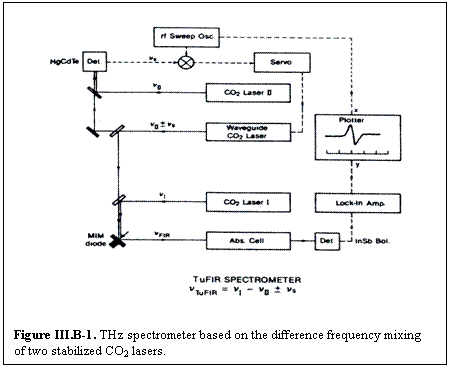
B. Sources Based on Mixing of Optical Sources: It has also long been recognized that difference frequency mixing of 'optical' sources could be used to produce Submillimeter/Terahertz radiation.1, 2 (2) Although the concept is straightforward, practical implementations depend upon the frequency stability and calibration of the lasers sources as well as upon the efficiency of the mixing process. 
One of the earliest spectroscopically successful implementation is shown in Figure III.B-1. This system based on the mixing of two lamb-dip stabilized CO2 lasers, along with a microwave synthesizer to provide tunability.3,4(3) Because the frequencies of the CO2lasers are about two orders of magnitude higher than that of the Submillimeter/Terahertz radiation produced, this system requires careful stabilization of each laser to provide measurement accuracy. However, because it is possible to choose CO2laser lines that are widely separated it is possible to get wide spectral coverage, with good sensitivity. Figure III.B-2 shows a nice example of the observation of the electronic quadrupole hyperfine structure of DI.5
Tunable laser sources in the visible and near infrared have also been used for difference frequency mixing sources. These have typically used photoconductive mixers in which radiating Submillimeter Terahertz antennas have been integrated with the semiconductor switch.6-10 (6) (7) (8) (9) (10) Since these sources operate at two to three orders of magnitude higher frequency than the Submillimeter Terahertz radiation produced, a number of frequency control and measurement schemes have evolved. 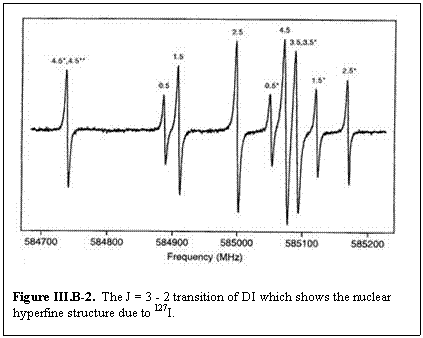
Figure III.B-3 shows an example of a spectrum taken with system in which two dye lasers were mixed in a photoconductive switch.11 Because this work was focused on measurements of pressure broadening, it was possible to calibrate the difference frequencies by the observation of the optical fringes produces by the scanning dye laser.
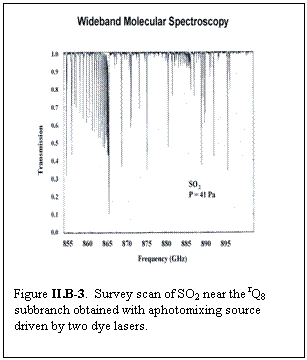
The system in Fig. III.B-4.10 is particularly interesting in that it provides a novel scheme for absolute frequency measurement. In this system, two cw diode lasers at 850 nm are locked to different orders of a FP cavity whose free spectral range is 3 GHz, while a third is offset locked to one of the cavity locked lasers via a tunable 3 – 6 GHz microwave oscillator. By knowledge of the free spectral range of the cavity, the difference in mode order between the two fixed locked lasers, and measurement of the microwave offset, absolute frequency calibration of 10-7 has been achieved.
'Size' as measured in wavelengths is an important limiting factor in 'electronic' approaches to THz technology. However, the 'dimensionality' of the device also plays an important role. Most harmonic generators, solid state sources, and frequency converters are '0-dimensional' devices, small in all three dimensions). An important example of a '1-dimensional' tube is the backward wave oscillator (BWO) discussed below. Much of its success can be traced to its macroscopic (in terms of wavelengths) length along the direction of the electron beam. Figure III.B-5 shows an example of a solid state mixer that takes advantage of this concept. Not only does its distributed interaction region allow the use of higher laser pump powers without burn out, also because the circuit elements are distributed, capacitance limitations on bandwidth are reduced.9
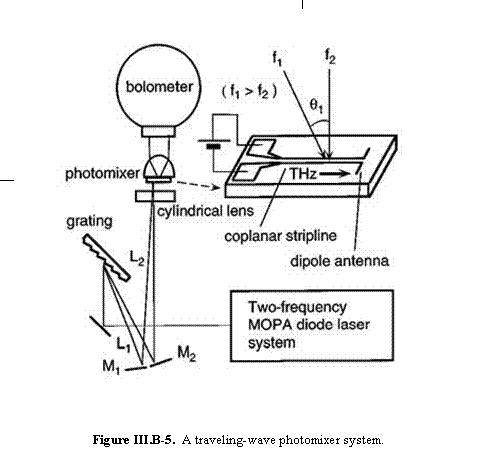
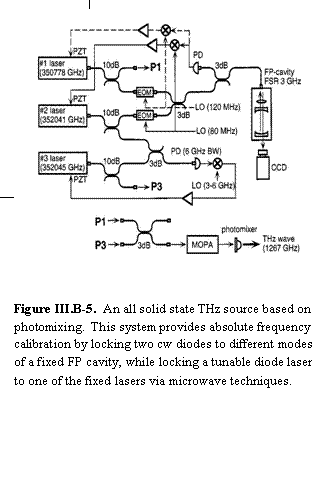
References
[1] S. S. Sussman, B. C. Johnson, J. M. Yarborough, H. E. Puthoff, R. H. Pantell, and J. SooHoo, in Submillimeter Waves, J. Fox, Ed. New York: Polytechnic, 1971, pp. 211.
[2] R. L. Aggarwal and B. Lax, "CW generation of tunable narrow-band far-infrared radiation," J. Appl. Phys., vol. 45, pp. 3972-3974, 1974.
[3] K. M. Evenson, D. A. Jennings, and F. R. Peterson, "Tunable far-infrared spectroscopy," Appl. Phys. Lett., vol. 44, pp. 576-578, 1984.
[4] K. M. Evenson, D. A. Jennings, K. R. Leopold, and L. R. Zink, in Seventh International Conference on Laser Spectroscopy, T. W. Hansch and Y. R. Shen, Eds. Berlin: Springer, 1985, pp. 300.
[5] T. D. Varberg, J. C. Roberts, K. A. Tuominen, and K. M. Evenson, "The Far-Infrared Spectrum of Deuterium Iodide," J. Mol. Spectrosc., vol. 191, pp. 384-386, 1998.
[6] E. R. Brown, K. A. McIntosh, F. W. Smith, K. B. Nichols, M. J. Manfra, and C. L. Dennis, "Milliwatt output and superquadratic bias dependence in a low-temperature-grown GaAs photomixer," Appl. Phys. Lett., vol. 64, pp. 3311-3313, 1994.
[7] E. R. Brown, K. A. McIntosh, K. B. Nichols, and C. L. Dennis, "Photomixing up to 3.8 THz in low-temperature-grown GaAs," Appl. Phys. Lett., vol. 66, pp. 285-287, 1995.
[8] S. Verghese, K. A. McIntosh, and E. R. Brown, "Highly tunable fiber-coupled photomixers with coherent terahertz output power," IEEE Trans. Microwave Theory Tech., vol. 45, pp. 1301-1309, 1997.
[9] S. Matsuura, G. A. Blake, R. A. Wyss, J. C. Pearson, C. Kadow, A. W. Jackson, and A. C. Gossard, "A Traveling-Wave THz Photomixer Based on Angle-Tuned Phase Matching," Appl. Phys. Lett., vol. 74, pp. 2872, 1999.
[10] S. Matsuura, P. Chen, G. A. Blake, J. C. Pearson, and H. M. Pickett, "A Tunable Cavity-Locked Diode Laser Source for Terahertz Photomixing," IEEE Trans. Microwave Theory and Tech., vol. 48, pp. 380-387, 2000.
[11] A. S. Pine, R. D. Suenram, E. R. Brown, and K. A. McIntosh, "A Terahertz Photomixing Spectrometer - Applications to SO2 Self-broadening," J. Mol. Spectrosc., vol. 175, pp. 37-47, 1996.